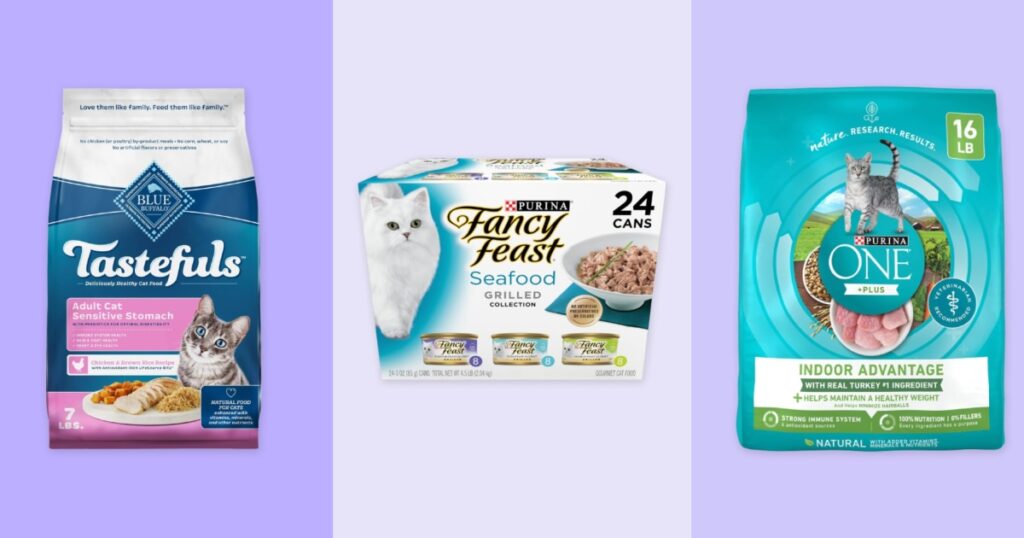Once cats are 1 year old, it’s typically time to transition them from kitten food to adult food. But there are dozens of options on the market, making deciding what to feed your pet difficult. Should you feed cats wet food, dry food or both? And how can you guarantee that the food you pick is packed with all the nutrients cats need? I talked to veterinarians about these questions, including how much — and how often — cats should eat every day. I also rounded up a handful of cat foods that meet expert guidance, including expert picks and those recommended by NBC Select pet parents like myself.
SKIP AHEAD The best wet cat food to shop | The best dry cat food to shop | How to shop for cat food | Why trust NBC Select?
How I picked the best cat food
While shopping for cat food, experts recommend considering the following factors:
AAFCO nutrition standards: The American Feed Control Officials (AAFCO) sets nutritional guidelines for pet food, and all the vets I spoke to recommend buying cat food with an AAFCO nutritional adequacy statement printed on the label. It should state that the food is “complete and balanced for all life stages.” Any cat food that’s AAFCO-compliant has the necessary nutrients to keep your pet healthy, like vitamins, minerals, fats, proteins and fiber, says Dr. Whitney Miller, a chief veterinarian at Petco. (Ed’s note: The inclusion of products sold by Petco in this article was made independently of Miller.)Ingredients: So long as you buy an AAFCO-compliant cat food, you don’t need to worry about specific ingredients, says Dr. Anna Kaufman, a veterinarian at Bond Vet. However, remember that a food’s nutrition label lists ingredients from highest to lowest amount by weight, so the first three are the most important, according to the AAFCO. Be sure to closely read the ingredient label if your cat has dietary restrictions or allergies.Food type: Cat food is available in wet and dry varieties, and cats can eat one or both types daily, says Kaufman. Talk to your vet about what they recommend for your pet based on its individual needs. Wet cat food is high in water content, so it supports hydration, while dry food is hard and crunchy, so it helps keep teeth clean by scraping off dirt and tartar, says Miller.Flavor and texture: Cat food comes in various flavors, like salmon, chicken, tuna and turkey. It also varies in texture. Dry food can be composed of small crunchy kibble or flatter, more tender pellets, while wet food can be crea
The best cat food of 2024
All of the cat food we recommend is AAFCO-compliant, as well as complete and balanced for all life stages. Each option is formulated for cats who follow a standard diet, but if your cat has dietary restrictions or specific health concerns, consult your vet about what’s best for their needs.
The best dry cat food
Best overall: Purina One Indoor Advantage Dry Cat Food
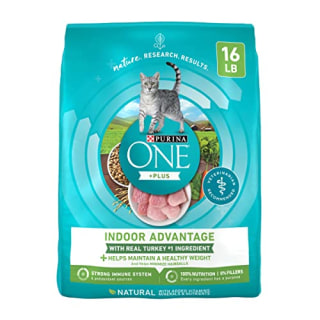
What we like
Two flavors availableFiber blend4 antioxidant sources
Something to note
Nothing to note at this time
This dry cat food won a NBC Select Pet Award and is the formula I regularly feed my cats, who are 1 and 3 years old. It’s a high protein option that’s made with a fiber blend, which helps cats maintain a healthy weight and minimizes hairballs, and four antioxidant sources that support your pet’s immune system, according to the brand. The food is made without artificial flavors and preservatives.
First ingredient: turkey | Texture: triangle pellets | Sizes: 7, 16, 22 or 32 lbs. | Other flavors: salmon
Best chicken recipe: Hill’s Science Diet Indoor Adult Dry Cat Food
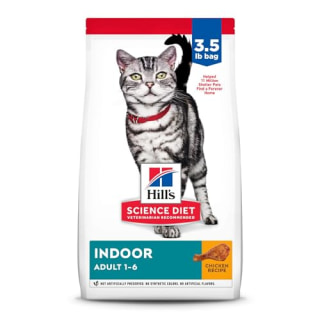
What we like
Formula avail. for older catsLean proteinAntioxidants and vitamins
Something to note
Only one flavor available
Kaufman recommends Hill’s Science Diet cat food, which is formulated for pets between 1 and 7 years old. The brand also sells an option for cats who are older than 7. It’s made with easy-to-digest ingredients like lean protein and fiber, as well as an antioxidant and vitamin blend to support the immune system. The food does not have artificial colors, flavors or preservatives.
First ingredient: chicken | Texture: triangle pellets | Sizes: 3.5, 7 and 12.5 lbs. | Other flavors: none
Best for hairball management: Royal Canin Indoor Adult Dry Cat Food
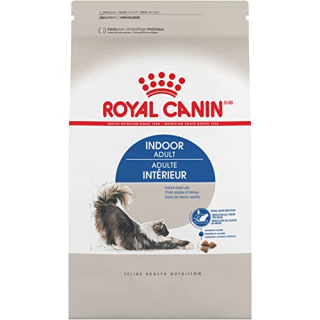
What we like
Formula avail. for older catsHelps reduce hairballsDigestible protein
Something to note
Only one flavor available
The fiber blend in this cat food helps with digestion and facilitates moving kibble, as well as the hair your cat swallows each day, through the intestinal tract to reduce hairballs, according to the brand. It’s also made with digestible protein and minerals that support oral health. This food is formulated for cats who are 1 to 7 years old — the brand sells an option for cats older than 7, too.
First ingredient: chicken meal | Texture: triangle pellets | Sizes: 2.5, 3, 5.5, 7 or 15 lbs. | Other flavors: none
Editor’s pick: Rachel Ray Nutrish Indoor Complete Premium Natural Dry Cat Food
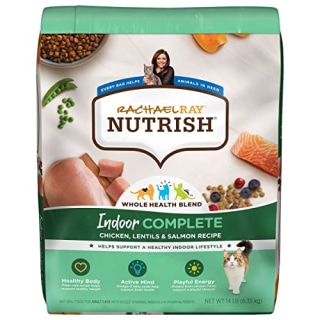
What we like
Protein, fruit & veggie blendVitamin EFiller-free
Something to note
Only one flavor available
Nikki Brown, NBC Select SEO editor, has two cats who are about 9 and 3 years old. She feeds them this dry cat food, which is made with a mix of proteins, fruits and vegetables like chicken, lentils, cranberries, blueberries and salmon. The kibble also has antioxidants like vitamin E to support immune health, and fatty acids that support cats’ skin and coat. The food doesn’t have any fillers or artificial flavors, colors and preservatives.
First ingredient: chicken | Texture: round pellets | Sizes: 3, 6 or 14 lbs. | Other flavors: none
Best salmon recipe: Iams Proactive Health Healthy Adult Dry Cat Food
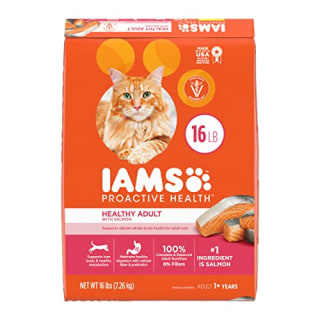
What we like
Two flavors availablePrebiotic fiberFiller-free
Something to note
Nothing to note at this time
If your cat doesn’t like meat like turkey or chicken, they may prefer a fish-based food like this one from Iams. It’s made with a fiber blend that includes prebiotics and beet pulp, which supports cats’ digestion and ability to absorb nutrients, according to the brand. The kibble also has nutrients like calcium and potassium. Iams does not include fillers, artificial flavors or article preservatives in its cat food.
First ingredient: salmon | Texture: round pellets | Sizes: 3.5, 7, 16 and 22 lbs. | Other flavors: chicken
Best for sensitive stomachs: Blue Buffalo Tastefuls Adult Sensitive Stomach Dry Cat Food
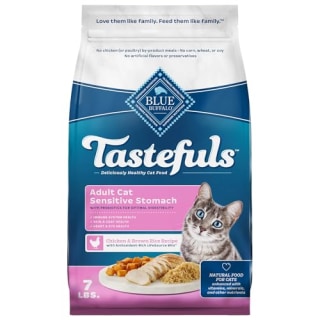
What we like
Prebiotic fiberNo wheat, cory or soyEasy to digest
Something to note
Only one flavor available
Blue Buffalo formulated this dry food for cats with sensitive stomachs. It does not contain corn, wheat, soy or poultry by-product meals, and there’s no artificial flavors or preservatives. The kibble is made with deboned chicken and brown rice, as well as a prebiotic to support digestion and antioxidants to support immune health.
First ingredient: deboned chicken | Texture: round pellets | Sizes: 3, 5, 7 10 or 15 lbs. | Other flavors: none
The best wet cat food
Best overall: Hill’s Science Diet Perfect Weight Adult Wet Cat Food
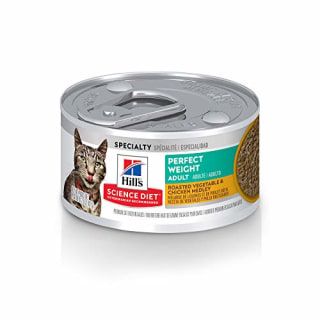
What we like
Multiple flavors availableSupports weight managementVisible whole ingredients
Something to note
Only one can size available
Hill’s Science Diet wet cat food, a NBC Select Pet Award winner, is made with lean protein, which can help cats maintain a healthy weight or lose weight if necessary, according to the brand. Depending on the flavor, you can see the whole ingredients in the food, like carrots, rice and spinach. It’s made without artificial colors and flavors.
First ingredient: chicken broth | Texture: stew | Sizes: 2.9-oz. can | Other flavors: minced liver & chicken, salmon & vegetable stew, turkey & vegetable stew
Best for picky eaters: Royal Canin Adult Instinctive Wet Cat Food

What we like
Two textures availableBalanced formulaEnticing scent and flavor
Something to note
Only one flavor available
Kaufman recommends Royal Canin wet food, which is made for cats who are between 1 and 7 years old. Its chewy slices come in gravy, giving it an enticing aroma that even picky pets are attracted to. The food also has a balanced blend of proteins, fats and carbohydrates that compliment its flavor. In addition to the slices in gray, you can purchase the food as a loaf in sauce, which has a softer, less chewy texture.
First ingredient: pork by-products | Texture: slices in gravy | Sizes: 3-oz. or 5.1-oz. can | Other flavors: none
Editor’s pick: Fancy Feast Grilled Wet Cat Food Seafood Collection
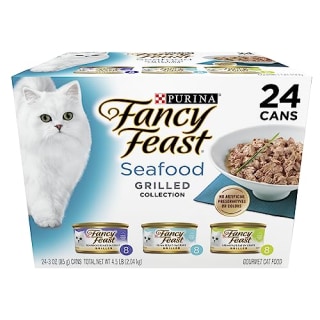
What we like
Flavor varietySavory gravyProtein-rich formula
Something to note
Only one can size available
My cats refuse to eat pâté-style wet food, and after much trial-and-error, I discovered that they love the tender, flakey texture of this option from Fancy Feast. They also seem to get bored of eating the same food multiple days in a row, so I like that this variety pack comes with three fish-based flavors — seafood feast, tuna feast and salmon feast — which makes it easy for me to mix up what I serve them. The protein-rich food comes in a light, savory gravy that adds to its taste, and it’s made without artificial colors or preservatives.
First ingredient: fish broth | Texture: flakes in gravy | Sizes: 3-oz. can | Other flavors: poultry and beef collection, can purchase three flavors individually or as variety pack
Best grain-free: Made By Nacho Adult Wet Cat Food
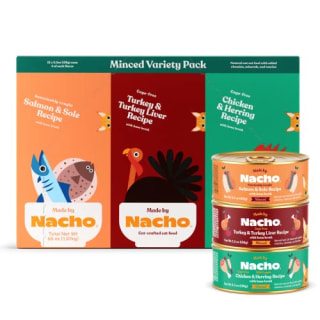
What we like
Bone brothFree from corn, wheat & soyTwo can sizes available
Something to note
Nothing to note at this time
My cats also love Made By Nacho’s cat food, which has a chunkier, softer texture compared to their favorite Fancy Feast option. This variety pack comes with three flavors: chicken & herring, salmon & sole and turkey & turkey liver. The high-protein food helps with digestion and it comes in a bone broth that amplifies its flavor. Made By Nacho’s wet cat food is free from corn, wheat and soy. It’s also made without artificial colors, flavors and preservatives.
First ingredient: salmon, turkey or chicken (flavor dependent) | Texture: minced | Sizes: 3-oz. or 5.5-oz. can | Other flavors: can purchase three flavors individually or as variety pack
Best for sensitive stomachs: Purina Pro Plan Sensitive Skin and Stomach Wet Cat Food
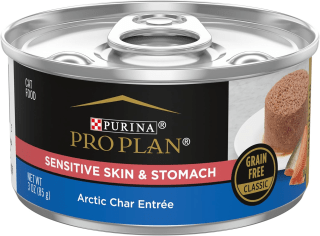
What we like
Prebiotic fiber25 vitamins and mineralsAntioxidant-rich
Something to note
Only one can size available
Purina made this wet food with prebiotic fiber, which helps with digestive health, especially for cats with sensitive stomachs, according to the brand. The grain-free formula comes as a soft pâté. It’s made with 25 essential vitamins and minerals, in addition to antioxidants and amino acids like vitamin A, taurine and linoleic acid.
First ingredient: arctic char | Texture: pâté | Sizes: 3-oz can | Other flavors: chicken, duck entrée
Best subscription service: Smalls

What we like
Frozen to preserve freshnessMultiple servings per packetHigh protein
Something to note
Must thaw prior to serving
Smalls is a subscription cat food company that sells high-protein wet entrées. They come frozen to preserve freshness and you thaw the food in your refrigerator prior to serving it. The pâté-style wet food is made with animal protein like beef, chicken, pork, turkey, cod and salmon. You take a quiz on Smalls’ website, which matches your cat with food based on their age, health conditions and flavor preferences. The quiz also asks about benefits you want to focus on, like less hairballs or digestive health. From there, you can customize each of your shipments, as well as cancel your subscription any time. Smalls sent me some of its cat food to try, which my cats enjoyed the flavor of, despite not being the biggest fans of pâté. Each entrée is pretty big, so I got a few meals out of each one, which I appreciated.
First ingredient: animal protein (flavor dependent) | Texture: pâté | Sizes: 5-oz. packet | Other flavors: varies based on shipment, options include ground bird, smooth pig and smooth fish
How to shop for cat food
AAFCO nutrition standards
The AAFCO is a nonprofit organization that sets standards for pet food in the United States, including nutritional adequacy, ingredient definitions, product labels and feeding directions, says Kaufman. Brands formulate and test their pet food against these standards to ensure they’re “complete and balanced” — this means the food contains the required nutrients in the correct ratios, according to the AAFCO. The nutrients and ratios necessary for each life stage vary, so the AAFCO’s nutrition standards differ accordingly. The AAFCO breaks life stages down into four groups: gestation/lactation, which is for pregnant and nursing animals; growth, which is for animals under 1 year old; maintenance, which is for adult animals; and all life stages, which is for animals of all ages.
All the experts I spoke to recommend buying AAFCO-compliant cat food. It’s the best and easiest way to guarantee you’re choosing a safe food that fully meets your pet’s nutritional needs. Look for an AAFCO nutritional adequacy statement on the food’s packaging, which is usually printed in small text on the back or side.
Ingredients
Cat food consists of protein, vitamins and minerals, fats and fibers, says Miller.
Protein: Cats are carnivores, so it’s crucial that their diet includes animal protein from meat or fish, like chicken, beef, salmon and tuna, says Dr. Bruce Kornreich, the director of the Cornell Feline Health Center in Ithaca, New York. Cats use it as energy to fuel their bodies, and it’s rich in amino acids like taurine, which is important for a cat’s heart, brain and reproductive health. You may see “animal by-products” or “animal by-product meal” listed as ingredients in cat food, which, contrary to popular belief, are not fillers, says Kornreich. By-products are parts of animals not used in the human food chain like organ meats, tissues and bones, and they’re nutritionally rich for pets.Vitamins and minerals: Some of the most important vitamins and minerals in cat food are calcium, which supports the bones, teeth, muscle control and ion balance; phosphorus, a vital nutrient for cell membrane and energy; and vitamin D, which regulates calcium and phosphorus balance, says Miller.Fats: Fat is an important energy source for cats and it helps their bodies absorb soluble vitamins, says Kornreich. Cats can’t produce omega-3 and omega-6 fatty acids on their own, so it’s added to their food. These fatty acids help fight inflammation and skin conditions, he says. Fiber: Fibers help support cats’ metabolism and overall health, says Miller.
Food type
There are two types of cat food: wet, which is moist and typically comes in a can or pouch, and dry, which is crunchy kibble that typically comes in a bag. Each type of food offers different benefits.
Wet cat food has a high water content and supports hydration, says Miller. It’s also easier to chew and digest, which is why senior cats sometimes prefer it over dry food.Dry cat food is hard and requires chewing, so it can help keep cats’ teeth clean by scraping off dirt and tartar, says Miller. It’s a particularly great option for cats who like to graze, meaning eat a little food at a time throughout the day instead of all in one sitting. Dry food doesn’t go bad if you leave it out for a few hours, while wet food does and you need to throw it out after about four hours. Dry food is also easy to travel with, and you can use it as cat treats or hide it in cat toys like puzzles and snuffle mats, says Kornreich.
You can feed your cat only dry food, only wet food or both types daily. “For cats without medical conditions, either option — or a combination of the two — will provide your pet with the nutrition they need, so it ultimately comes down to preference,” says Miller. Talk to your vet about what they recommend, and pay attention to what your cat gravitates toward. Also keep in mind that feeding your cat wet and dry food when they’re young is often beneficial because it familiarizes them with both types, and may make it easy to transition to one or the other if necessary later in their life, says Kornreich.
Frequently Asked Questions
How much should you feed your cat?
Cat food typically has feeding guidelines online or on its packaging — use them to measure out how much food you should give your pet each day, says Kaufman. Portion sizes vary between foods, and may even vary between flavors, says Miller. Also discuss your cat’s individual needs with your vet. You may need to adjust how much you’re feeding them if they’re too thin or too heavy, and appropriate serving size changes throughout a cat’s life, says Miller.
What’s the difference between free feeding and meal feeding cats?
When it comes to feeding cats, there’s two common methods:
Meal feeding , which involves giving cats a measured amount of food at specific times a day, like 9:00 a.m. for breakfast and 6:00 p.m. for dinner. The younger cats are, the more frequently they need to be fed — kittens typically eat about three to six meals a day, while adult and senior cats usually eat about two to three meals a day, says Miller. Free feeding , which involves leaving a measured amount of food out all day for cats to graze at their leisure. Whether you should meal-feed or free-feed your cat is a personal choice, says Kaufman. It depends on their preferences, overall nutritional needs and health status.
However, Miller usually recommends meal feeding cats. “Cats that are free-fed run the risk of overeating and gaining weight, making them susceptible to diabetes and joint issues, among other health concerns,” she says. “But if pet parents choose to free-feed, I recommend only putting out a day’s portion at a time to reduce the risk of the cat overeating and becoming obese.”
What’s the difference between food for kittens, adult cats and senior cats?
Cats’ nutritional needs change throughout their life, so brands develop their foods to support different age groups.
Kitten food is formulated to help young cats grow, says Kaufman. It typically has more calories, as well as higher levels of phosphorus and calcium to help with bone development, says Miller. Talk to your vet about what they recommend for your pet, but you can typically transition a cat from kitten food to adult food at about 1 year old, says Kaufman.
Adult cat food is formulated to help cats maintain a healthy weight while providing them with necessary nutrients. Some cats may need to follow a specialized diet, like one that avoids their allergies or helps with weight control, hairball control or urinary health, says Miller. Your vet can help you decide which specialized food to buy if needed, or may recommend a prescription cat food.
Food for senior cats tends to be lower in calories and fat to support weight management, says Miller — like humans, cats’ metabolisms slow down as they age. It also has different quantities of vitamins and minerals to support older cats’ heart, dental and immune health.
Is a raw food diet safe for cats?
A raw food diet involves feeding your pet uncooked animal products, like muscle meat, organ meat and bones, says Miller. It mimics what your cat might eat in the wild, and is free from artificial additives some brands add to food to preserve freshness.
Because raw food is uncooked, it can contain bacteria and parasites that are dangerous to pets, as well as to humans, says Kornreich. Thus, he does not recommend feeding your cat a raw food diet.
Is a grain-free diet safe for cats?
Grains are beneficial for your cat to eat and provide lots of nutritional value — they’re rich sources of nutrients like iron, calcium and B vitamins. But some cats have allergies or sensitivities to certain grains, and if so, choosing a grain-free cat food may be necessary, says Miller. Grain-free food is made without grains like wheat, corn or rice. Instead, brands incorporate carbohydrates into their food via potatoes or peas.
Overall, research shows that grain-free food is safe for cats, but there is evidence that it may lead to a type of heart disease in dogs, says Kornreich. Talk to your vet about what they recommend for your pet.
How do you switch cat foods?
If you want to start feeding your cat a new brand, flavor or type of food, introduce it slowly, says Kaufamn. “I recommend transitioning diets over at least a week period,” she says. “Give a fourth of the new diet mixed with three fourths of the old diet for a few days. Then mix half and half for a few days, then give them a fourth of the old diet with three fourths of the new one for a few days until they’re ready to fully transition.”
Changing a cat’s food too quickly can cause them to experience an upset stomach, diarrhea, vomiting or a loss of appetite, says Miller. Keep a close eye on your cat while they’re transitioning to a new food, and consult your vet if you have concerns. If your pet begins refusing to eat or shows signs of an upset stomach, slow down the rate at which you’re transitioning them to the new food, says Miller.
Meet our experts
At NBC Select, we work with experts with specialized knowledge and authority based on relevant training and experience. We also ensure that all expert advice and recommendations are made independently and without undisclosed financial conflicts of interest.
Dr. Anna Kaufman is a veterinarian at Bond Vet.Dr. Whitney Miller is a chief veterinarian at Petco. (Ed’s note: The inclusion of products sold by Petco in this article was made independently of Miller.)Dr. Bruce Kornreich is the director of the Cornell Feline Health Center in Ithaca, New York.
Why trust NBC Select?
I’m an associate updates editor at NBC Select where I cover pet products, including articles about flea treatments and preventatives, cat toys, kitten food and cat travel carriers. For this article, I interviewed three veterinarians about how to shop for the best cat food. I also rounded up cat food that meets expert guidance, including vet picks and recommendations from NBC Select pet parents like myself. I have two cats and have volunteered at animal shelters across New York for about a decade.
Catch up on NBC Select’s in-depth coverage of personal finance, tech and tools, wellness and more, and follow us on Facebook, Instagram, Twitter and TikTok to stay up to date.

